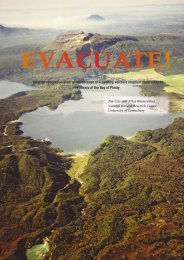Volcanoes - Ministry of Civil Defence and Emergency Management
Volcanoes - Ministry of Civil Defence and Emergency Management
Volcanoes - Ministry of Civil Defence and Emergency Management
You also want an ePaper? Increase the reach of your titles
YUMPU automatically turns print PDFs into web optimized ePapers that Google loves.
The majority <strong>of</strong> Auckl<strong>and</strong>'s 1.3 million people reside on the potentially active Auckl<strong>and</strong> Volcanic Field (AVF). In a survey <strong>of</strong> Auckl<strong>and</strong> residents in 2000,<br />
while 92% were aware that Auckl<strong>and</strong> is built on a volcanic field, over 67% perceived it as being dormant.<br />
These studies use determinant factors such as hazard<br />
awareness, proximity to a volcano, perceived likelihood<br />
<strong>of</strong> future disasters, level <strong>of</strong> impact <strong>and</strong> past experiences<br />
<strong>of</strong> disaster impact.<br />
AUCKLAND<br />
The majority <strong>of</strong> Auckl<strong>and</strong>’s 1.3 million people<br />
reside on the potentially active Auckl<strong>and</strong> Volcanic<br />
Field. This field covers approximately 360km 2 <strong>and</strong><br />
extends from Manuwera in the south to Takapuna in<br />
the north <strong>and</strong> contains about 50 volcanoes. While none<br />
<strong>of</strong> the existing volcanoes are expected to erupt again,<br />
a new volcano may erupt in this field at any location,<br />
at any time. Due to this r<strong>and</strong>om nature <strong>and</strong> the large<br />
population, only a relatively small eruption will be<br />
enough to cause major problems. Auckl<strong>and</strong> is also<br />
capable <strong>of</strong> being affected by tephra fall from eruptions<br />
originating in the Taupo Volcanic Zone (TVZ) <strong>and</strong> from<br />
Mt. Taranaki/Egmont. The 1995/96 Ruapehu eruptions<br />
resulted in only ~1mm <strong>of</strong> ashfall on Auckl<strong>and</strong>, but this<br />
was enough to cause disruptions to essential services <strong>and</strong><br />
transport.<br />
Following a volcanic hazard information<br />
campaign (poster distribution) produced by the<br />
Auckl<strong>and</strong> Regional Council, GNS <strong>and</strong> the Earthquake<br />
Commission, a study by Ballantyne <strong>and</strong> others (2000)<br />
found that nearly all <strong>of</strong> the Auckl<strong>and</strong> residents surveyed<br />
(92%) were aware that Auckl<strong>and</strong> is built on a volcanic<br />
field. However, a majority viewed the AVF as being<br />
dormant (67%), rather than potentially active. Just<br />
over half (55%) thought that Auckl<strong>and</strong> is prone to<br />
volcanic eruptions <strong>and</strong> less than half (47%) perceived<br />
that a volcanic eruption is likely in the next 50 years.<br />
Although these results were marginally better than the<br />
pre-information campaign results, increased awareness<br />
<strong>of</strong> the volcanic nature <strong>of</strong> the Auckl<strong>and</strong> region did not<br />
translate into increased perceived risk <strong>of</strong> this hazard.<br />
Two questions in the study further examined risk<br />
perceptions through testing recall <strong>of</strong> information specific<br />
to the poster.<br />
Firstly, the poster stated that the largest last<br />
eruption in Auckl<strong>and</strong> was the eruption <strong>of</strong> Rangitoto,<br />
about 700 years ago.<br />
Yet only a low percentage (12%) <strong>of</strong> respondents<br />
correctly recalled that the last major eruption in<br />
Auckl<strong>and</strong> occurred between 500-700 years ago <strong>and</strong> over<br />
a third (35%) were unsure <strong>of</strong> the timing.<br />
Secondly, the poster stated that it was unlikely<br />
that a future eruption would occur at the site <strong>of</strong> an<br />
existing cone.<br />
Over half the respondents (53%) ‘recalled’ that<br />
the next eruption will occur from an existing cone, with<br />
only a third (31%) correctly stating that an eruption will<br />
occur in another location.<br />
As underst<strong>and</strong>ing <strong>of</strong> these issues remained<br />
relatively poor, so did risk perception. The fact that a<br />
majority <strong>of</strong> the respondents perceive a threat from an<br />
existing cone causes problems as those not living close to<br />
a cone will perceive little risk. As acknowledged in the<br />
report, future information campaigns need to examine<br />
61<br />
TEPHRA<br />
June 2004

















